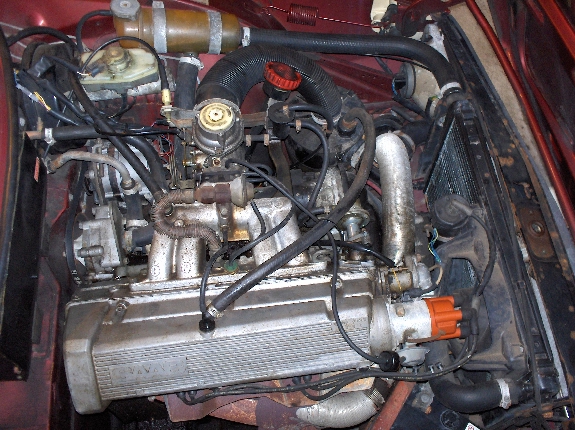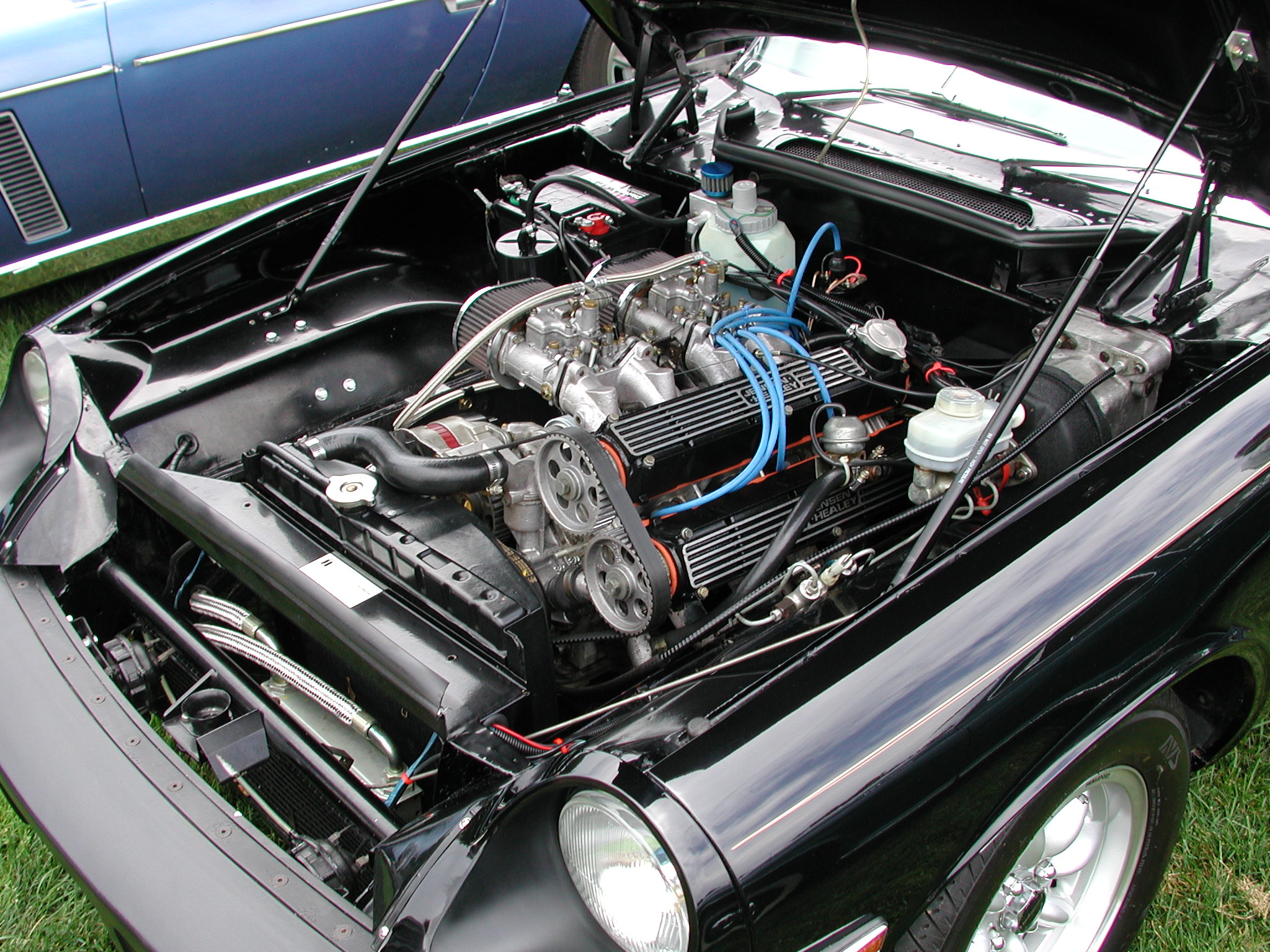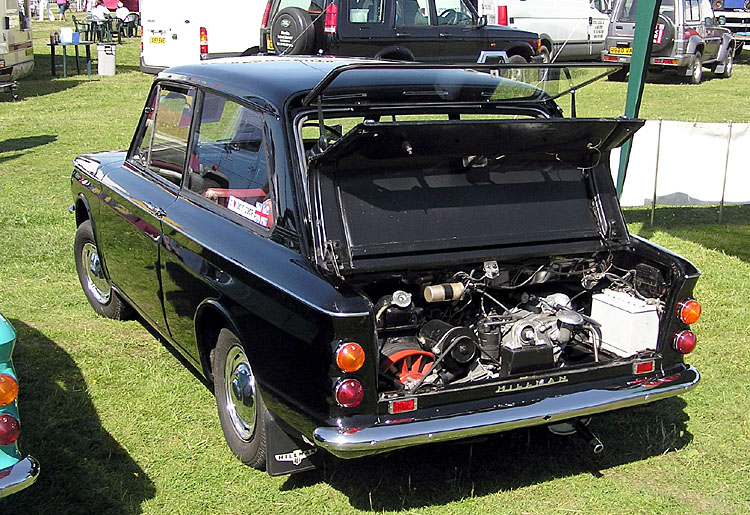|
Slant-4 Engine
Slant four or Slant-4 was a name given to several unrelated engines produced by different manufacturers. These were all in-line four-cylinder engines with cylinders inclined from vertical. They include: * Vauxhall Slant-4 engine (a planned V8 version never materialized) * Triumph Slant-4 engine (4-cylinder variant of Triumph V8) ** Saab B engine (a version of the Triumph Slant-4 engine built by Saab with modifications) ** Saab H engine (a redesigned Saab B engine built by Saab) Other inline four-cylinder engines with a similar layout, but without the official name, include: * Pontiac Trophy 4 engine (4-cylinder variant of Pontiac V8 engine) * International Harvester Comanche 4 (4-cylinder variant of International Harvester Comanche V8) * Lotus 900 series (a planned production V8 never materialized, but did appear in the Lotus Etna concept car) * Hillman Imp engine * Volvo Redblock Engine The Volvo B21 is a slanted straight-four engine first used in the Volvo 200 series, mean ... [...More Info...] [...Related Items...] OR: [Wikipedia] [Google] [Baidu] |
Inline-four Engine
A straight-four engine (also called an inline-four) is a four-cylinder piston engine where cylinders are arranged in a line along a common crankshaft. The vast majority of automotive four-cylinder engines use a straight-four layout (with the exceptions of the flat-four engines produced by Subaru and Porsche) and the layout is also very common in motorcycles and other machinery. Therefore the term "four-cylinder engine" is usually synonymous with straight-four engines. When a straight-four engine is installed at an inclined angle (instead of with the cylinders oriented vertically), it is sometimes called a slant-four. Between 2005 and 2008, the proportion of new vehicles sold in the United States with four-cylinder engines rose from 30% to 47%. By the 2020 model year, the share for light-duty vehicles had risen to 59%. Design A four-stroke straight-four engine always has a cylinder on its power stroke, unlike engines with fewer cylinders where there is no power stroke occu ... [...More Info...] [...Related Items...] OR: [Wikipedia] [Google] [Baidu] |
Vauxhall Slant-4 Engine
The Vauxhall Slant-4 (or Slant Four) is an inline-four engine, inline four-cylinder petrol automobile, car engine manufactured by Vauxhall Motors. Unveiled in 1966, it was one of the first production overhead camshaft designs to use a Timing belt (camshaft), timing belt to drive the camshaft. The Slant-4 block was used as a development mule for the Lotus 900 series of engines. Vauxhall used the engine in a variety of models until production ended in 1983. History Design The Slant-4 gets its name from the fact that its cylinder (engine), cylinders are inclined at an angle of approximately 45° from vertical. This layout came about because Vauxhall had originally planned to develop a whole family of engines all built on the same production line. There were to be slant-4s and V8s in both petrol and diesel versions, designed under the guidance of Vauxhall's then chief engineer, John Alden. Although a V8 petrol prototype and several 4-cylinder diesel prototypes were built only the 4-c ... [...More Info...] [...Related Items...] OR: [Wikipedia] [Google] [Baidu] |
Triumph Slant-4 Engine
The Triumph slant-four is an inline four-cylinder petrol car engine developed by the Triumph Motor Company. It first appeared in 1968 in the Saab 99. The first Triumph model to use the engine did not appear until 1972. With an original capacity of 1.7 L, displacement grew over time to 2.0 L. Triumph production ended in 1981. History In 1963 Triumph's Chief Engine Designer Lewis Dawtrey presented the results of his analysis of future engine technology trends and Triumph's anticipated needs. After evaluating rotary, horizontally opposed, V4 and V6 configurations Dawtrey recommended an OHC engine family composed of both Inline-4 and V8 engines that could be built with the same tooling. The new range would be built in capacities of 1.5 L to 3.0 L, allowing it to replace both the four-cylinder Standard SC and derivative Triumph I6 engines whose roots reached back to the Standard Eight of 1953. The recommendation was accepted and development began in-house at ... [...More Info...] [...Related Items...] OR: [Wikipedia] [Google] [Baidu] |
Triumph V8
The Triumph V8 is a 3.0 litre V8 developed and built by the Triumph Motor Company for the Triumph Stag. The engine was a development of the Triumph slant-four engine. It consisted of a cast iron block and aluminium cylinder heads with a single overhead cam per bank. Development The Stag was developed between 1964 and 1969. Whilst originally seen as little more than a convertible version of the Triumph 2000 saloon, as development progressed the Stag gained its own identity until the final design shared no body panels or pressings with the 2000. The Stag was intended to use Triumph's existing 2.5-litre straight-6 engine. When the Stag design evolved into a grand tourer rather than a more conventional sports car it became clear that a more powerful, more refined engine was needed. As far back as 1963 the designer of the Triumph Slant-4 engine, Lewis Dawtrey, had foreseen the possibility that the engine design could be 'doubled-up' to create a V8 unit. This was not a unique app ... [...More Info...] [...Related Items...] OR: [Wikipedia] [Google] [Baidu] |
Saab B Engine
The Saab B engine is an inline four-cylinder car petrol engine developed by Saab Automobile. A redesign of the Triumph slant-four engine, the B engine displaced 2.0 L and first appeared in 1972. The B engine was used in the Saab 99 and 900 models. Saab began to phase the engine out in 1981. History In the early 1960s Rolf Mellde, Per Gillbrand and Karl Rosenqvist began work on a new 1.2 L inline four for the upcoming Saab 99. UK engineering and consultancy company Ricardo was involved in the project, and were also aware that Triumph in the UK were working on a similar engine. When Saab determined that developing their own engine would be too expensive and too risky, Ricardo put Saab in contact with Triumph. Triumph agreed to supply Saab with 50,000 engines per year for the new 99. Displacement was 1.71 L at first, and was increased to 1.85 L later. Saab had exclusive use of the slant-four for the first several years of production. Saab designed a new transaxle ... [...More Info...] [...Related Items...] OR: [Wikipedia] [Google] [Baidu] |
Saab H Engine
The Saab H engine is a redesign of the Saab B engine, which in turn was based on the Triumph Slant-4 engine. Despite the name it is not an H engine or horizontally opposed engine, but a slanted inline-4. The H engine was introduced in 1981 in the Saab 900 and was also used in the Saab 99 from 1982 onwards. H stood for high compression; higher compression was part of the update from B to H engine. It continued in use in the 900/ 9-3, 9000, and 9-5. The 2003 GM Epsilon-based 9-3 switched to the GM Ecotec engine, leaving the 9-5 as the sole user of the H engine. The H family of engine was used in the first-generation 9-5 until it was discontinued in 2010. The tooling and know-how was sold to BAIC. The latter B2X4 and B2X5 engines have in practice nothing in common with the early B engines except cylinder spacing. All versions feature a grey cast iron block and an aluminum head with a single or double overhead chain driven camshafts. SOHC engines use two valves per cylinder and ... [...More Info...] [...Related Items...] OR: [Wikipedia] [Google] [Baidu] |
Pontiac Trophy 4 Engine
The Pontiac Trophy 4 engine (also called the ''Indianapolis 4'', or ''Indy 4'') is a inline four-cylinder engine produced by the Pontiac Motor Division of General Motors for model years 1961 through 1963. Created from one bank of Pontiac's powerful '' Trophy V8'', its only application was in the first generation Pontiac Tempest. It was dubbed by Pontiac the ''Trophy 4'', playing off the racing success that had earned the 389 V8 engine the nickname ''Trophy V-8'' after just two years of competition. History The Trophy 4 engine is a short-stroke, 45-degree inclined inline four created from the right bank of the 389 V8 for the debut of the Tempest in 1961. Its displacement is precisely half of the 389, with an identical bore and stroke of . It shared most of the 389's tooling and up to 120 of its parts. This degree of commonality enabled it to be produced on the same lines as the V8, allowing substantial cost savings. The Trophy 4 weighs about , as compared to the V8 it was ba ... [...More Info...] [...Related Items...] OR: [Wikipedia] [Google] [Baidu] |
Pontiac V8 Engine
The Pontiac V8 engine is a family of overhead valve 90° V8 engines manufactured by the Pontiac Division of General Motors Corporation between 1955 and 1981. The engines feature a cast-iron block and head and two valves per cylinder. Engine block and cylinder heads were cast at Saginaw Metal Casting Operations then assembled at Tonawanda Engine before delivery to Pontiac Assembly for installation. Initially marketed as a , it went on to be manufactured in displacements between and in carburated, fuel injected, and turbocharged versions. In the 1960s the popular version, which had helped establish the Pontiac GTO as a premier muscle car, was cut in half to produce an unusual, high-torque inline four economy engine, the Trophy 4. Unusual for a major automaker, Pontiac did not have the customary "small-block" and "big-block" engine families common to other GM divisions, Ford, and Chrysler. Effectively, Pontiac's V8s were all small blocks, sharing the same connecting rod length ... [...More Info...] [...Related Items...] OR: [Wikipedia] [Google] [Baidu] |
Lotus 900 Series
The Lotus 900 series is a family of internal combustion engines designed and built by Lotus Cars of United Kingdom. Successor to the Lotus-Ford Twin Cam, the 900 was the first complete engine developed by Lotus. The engine was built from 1972 to 1999. Background As early as 1964, Lotus recognized the need to find a replacement for the Lotus Twin Cam engine. Colin Chapman issued a brief that listed the features to be required in a new engine, including 'high efficiency, flexibility, torque and smoothness which was suitable for hand assembly'. Unable to find this combination in any existing engine, the company used outside consultants and internal resources to define the characteristics of the next Lotus engine. After having rejected a 120° V6 due to being too wide for Lotus' chassis and a 60° V6 as too tall for the intended bodywork, the engineers determined that a 2-litre inline-four engine was the optimal choice. This future engine would have four valves per cylinder (16 val ... [...More Info...] [...Related Items...] OR: [Wikipedia] [Google] [Baidu] |
Lotus Etna
The Lotus Etna is a one-off concept car designed by Giorgetto Giugiaro, who also designed the Lotus Esprit. It premiered at the 1984 British International Motor Show The British International Motor Show is an annual motor show held by the Society of Motor Manufacturers and Traders between 1903 and 2008 in England, and as The British Motor Show since 2021 by Automotion Events. Initially held in London at T .... It is powered by a 4.0-litre V8 of Lotus design, code-named the Type 909. External linksLotusSpiritTurbo.com Etna Italdesign concept vehicles {{Auto-stub ... [...More Info...] [...Related Items...] OR: [Wikipedia] [Google] [Baidu] |
Hillman Imp
The Hillman Imp is a small economy car that was made by the Rootes Group and its successor Chrysler Europe from 1963 until 1976. Revealed on 3 May 1963, after much advance publicity, it was the first British mass-produced car with the engine block and cylinder head cast in aluminium. Being a direct competitor to the BMC's Mini, it used a space-saving rear-engine, rear-wheel-drive layout to allow as much luggage and passenger capacity as possible in both the rear and the front of the car. It used a unique opening rear hatch to allow luggage to be put into the back seat rest. It was the first mass-produced British car with the engine in the back and the first to use a diaphragm spring clutch. The baulk-ring synchromesh unit for the transaxle compensated for the speeds of gear and shaft before engagement, from which the Mini had suffered during its early production years. It incorporated many design features which were uncommon. Among them were a folding rear bench seat, autom ... [...More Info...] [...Related Items...] OR: [Wikipedia] [Google] [Baidu] |
Volvo Redblock Engine
The Volvo B21 is a slanted straight-four engine first used in the Volvo 200 series, meant to replace the B20. The B21 and all derived engines are often referred to as ''red block'' engines for the red paint applied to the block. The primary differences when compared to the B20 was the switch to a SOHC in place of the older pushrod configuration, and an aluminum crossflow cylinder head versus the iron head of the B20. History Initially the overhead camshaft versions were offered as optional equipment on the 240, becoming standard in all markets by the 1976 model year. The overhead camshaft motors were available in displacements of 2.0 (B19 and B200), 2.1 (B21), and eventually 2.3 (B23 and B230) litres. The B21 featured an stroke, and bore. In the US, the B21's power output ranged anywhere between and , based on variations in the compression ratio and was typically supplied with a B or M camshaft. The engines are tilted approx 15 degrees to right (exhaust side) to make room for ... [...More Info...] [...Related Items...] OR: [Wikipedia] [Google] [Baidu] |





.jpg)

